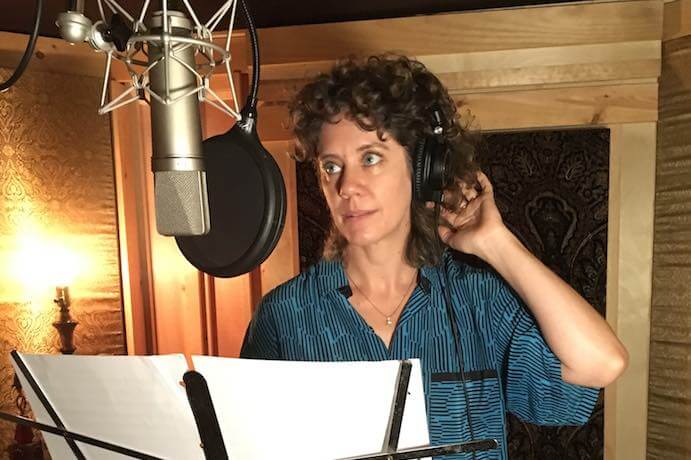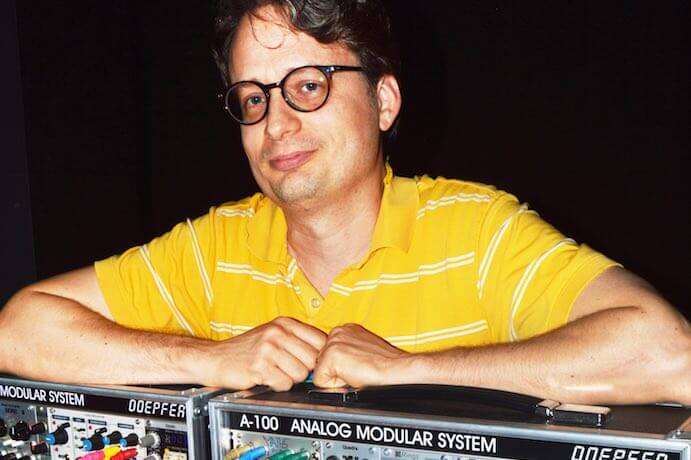With true crime podcasts currently topping charts thanks to offerings like Gladiator, which tells the story of Patriot’s football player and convicted murderer Aaron Hernandez, and many scripted crime-centered podcasts being pumped full of production value like 2017’s Homecoming, which went on to be remade this year into the Amazon hit series starring Julia Roberts, perhaps it’s no surprise that composer and opera producer Jason Cady has turned his talents towards a podcast opera concerning his hometown of Flint, Michigan. Jam-packed with intrigue, funk-inspired musical interludes, certain death, and just a bit of time travel, the four-episode saga Buick City 1:00 AM brings nostalgia, groove, auto-centric Michigan, and opera to your favorite podcast app, wrapped up in a top-notch, gorgeously produced package.
Tell us a little about growing up in Flint, Michigan. Has it always been a place you’ve wanted to write about and set a work in?
My entire family worked for Buick. My parents met on the assembly line. My great-grandfather was in the Flint Sit-Down Strike of the 1930s, in which workers occupied their factory for a whole month until GM gave into their demands. This legitimized the UAW, which helped workers across the US. Growing up, there was always a possibility that the union would declare a strike. A local grocery store had a picket line outside it during my entire childhood.
My best friend died when we were teenagers, and Buick City 1:00 AM became an homage for him. My friend was buried with a Detroit Red Wings hockey stick and a VHS tape of Bill and Ted’s Excellent Adventure, so I wrote a time travel story and set it in Michigan for him. There are many personal references in the story that listeners won’t identify, but I think they still leave behind emotional marks that resonate.
I believe that setting matters. Too many stories take place in NYC and LA. People need stories that happen where they live (and New Yorkers and Californians need stories about other places). Flint is one of the forgotten cities of the Rust Belt. It got some attention a few years ago because of the water crises—which is important—but Flint’s history is bigger than that.
When I first dreamed up Buick City 1:00 AM, I only had the murder mystery plot figured out. It was later that I decided to set it in Flint, partially just because that made more sense to me than putting it in a city that I didn’t grow up in. And once I chose the setting, everything else fell into place. I knew the death of Wayne, the father in Buick City 1:00 AM, would embody the death of the working class; and that I would summon my demons, jumble them up, and remix them.

Katie Eastburn recording Buick City 1:00AM
Talk to us about your musical decisions in Buick City 1:00AM. What were the bands/music from the time period the work is set in that inspired you while composing the opera?
I gave each of the seven characters a drone. The protagonist, Elena, is A, and the other characters make up the rest of the natural A minor scale. So, in every scene of dialogue, there are different combinations of two or three drones that sustain throughout to represent the characters. When a character enters or exits you hear their note come in or disappear. The songs in between scenes are always from the perspective of a specific character, so they are in the key of that character.
When Herbie Hancock came out with Rockit in 1983, I flipped out and begged my parents for a synthesizer, and they got me a little Casio. Some listeners might hear a semblance of 80s pop in Buick City 1:00 AM, but I’m not necessarily trying to evoke that music. When composing, my departure point was first the lyrics I had written, and then the key that represented the character. From there, I tried different structures. For example, in one song, the bass and drums alternate two bars of 7/8 with two bars of 5/8 in cycles, while the singers and piano are consistently in 6/8 so everyone’s downbeats coincide every four bars.
Was there a specific podcast that you were listening to when you came up with the idea to write a podcast opera?
I got my interest in podcasts from my wife, Ann Heppermann. She’s a radio and podcast producer, and she teaches writing for radio at Sarah Lawrence College. She won’t let me attend her class, but I’ve been sort of a full-time student of hers for the last 11 years. Long before Buick City 1:00 AM, fiction podcasts inspired me to bring sound design into my operas, which connected with my earlier interest in things like Musique Concrète.
Ann and I have worked together on other radio related projects. We collaborated on a sound installation called Chorus of Refuge in 2008. Our source material for it came from an NPR series Ann made with Kara Oehler about refugees, which aired on Weekend America.
As a big consumer of podcasts, I’m bowled over by the sonic quality of Buick City 1:00AM. Do you have any good stories about the process of putting all these myriad components together?
Some fiction podcasts try to sound like radio drama from the golden age, but many of the new fiction podcasts consciously reject that aesthetic. One of the big differences between the two approaches is where they record. The old radio dramas recorded in studios with sound effects added by Foley artists. The new shows record on location, which gives them realistic ambience, and even when they don’t record on location they still mix in ambient sounds so there’s not the dead space of a studio interrupted by occasional jolts of Foley.
Ann recorded everything on location for Buick City 1:00 AM. She recorded the outdoor scenes outside, which is challenging in NYC since there is so much street noise. The scenes that take place in cars we recorded inside cars to capture the acoustics of a car interior. We recorded the indoor scenes in different rooms in our apartment. When scenes included motion, Ann followed the actors with microphones. When the characters ate, drank, and smoked we had the actors do those things. We recorded the protagonist’s interior monologues inside a vocal booth for a totally dry sound since there is no reverb inside our skulls. Instrumental snippets from the songs (sometimes processed through my modular synth) are mixed in with the drones and ambient sounds during the scenes.
Ann Heppermann, Halley Devestern, and Annie Sage-Whitehurst recording Buick City 1:00AM
It was also crucial to hire actors who could do working-class Michigan accents. I auditioned many actors and was lucky to find Joshua R. Pyne, who played Wayne, and grew up in Flint. Also, Scott Watson, who played Bud, grew up in Grand Rapids, Michigan. Some of the other actors were from other parts of the midwest, or had connections to it. I also had a section about the Michigan dialect in my opera Post-Madonna Prima Donna from 2001.
I read dozens of books and visited various locations in Flint, I interviewed family members and a childhood friend who I discovered had worked in HR at Buick. My father and one of his friends read a scene and gave me feedback. I strove for accuracy, because I am so often disappointed by stereotyped portrayals of working class people.
Some people questioned whether Buick City 1:00 AM is an opera. I have a couple responses. First, I didn’t actually call it an opera, I called it a podcast opera. It’s a combination of the two forms. The second is that I not only have a broad sense of what opera is, I also have a broad sense of what music is. The dialogue in Buick City 1:00 AM is spoken, not sung, but the textures are rich with the kinds of sounds that composers have experimented with for the last 80 years.
You’ve written an opera with modular synthesizer, you’ve written operas about time travel and technology, and now you have created a podcast opera. Is there another medium like podcasts that you think should be given the operatic treatment?
I founded Experiments in Opera with Aaron Siegel and Matthew Welch, and we have dabbled in new media for opera, but that’s just part of what EiO does. In the spring of 2019, we’re producing Chunky in Heat. The libretto is by A.M. Homes and five composers join me in writing the music: Paula Matthusen, Erin Rogers, Shelley Washington, Aaron Siegel, and Matthew Welch.
Next year, we’re co-presenting Looking At You by Kamala Sankaram, who has just become my Co-Artistic Director at EiO. It’s a re-telling of the movie Casablanca updated to deal with issues surrounding surveillance and privacy. There’s a complicated techie aspect to it: after audience members click on a standard user agreement their digital footprint gets incorporated into the show. But what’s important to me is not the technical innovation, it’s that it results in powerful theater.
I’m not a technophile. My operas I Screwed Up the Future about Y2K and Candy Corn about suicide over social media were both critiques of the internet. What opera needs today is what it has always needed: compelling, original fiction enhanced by everything that music and theater make possible.

